 Posted by: Lois Lindemann on: September 16th, 2013  Posted in: Everything Tags for this post: Art | Wirksworth Festival 2013.  - (Comments are closed)Where was I? Some visitors turned up, so I’ve been a bit busy with other things 😉
Anyway, here’s a few more bits and pieces from Wirksworth:
We went to see Niall Young, who was dotting away on Rainbow Warrior – I forgot to take a photo, but came away with a very nice print. We loved Lucy Gell’s whimsical illustrations – and I’m sure Mr TLC’s granddaughters will love the greetings cards/mobiles that we’ve stashed away for their next birthdays. The granddaughters aren’t really old enough to appreciate Corrina Rothwell’s quirky humour, but we liked it – so that’s a few more greetings cards stashed away ready for the forthcoming October-birthday-fest.
We found Rupert the Bear in the maker’s market (and yes, of course we sang the song – but only quietly, because we are very polite):
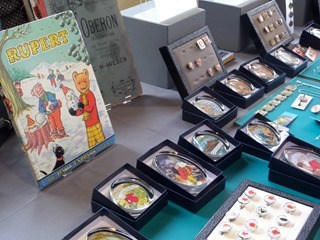 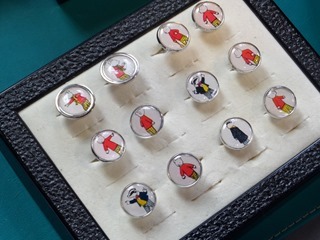
There was a “SQUIRREL!” in a garden – one of several woven sculptures by Paul Higginson:
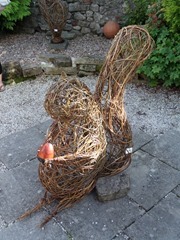
And finally, one of my favourites this year: Olivia Punnett’s ‘Greenhill Intervention’. Greenhill is a narrow street, lined with stone cottages. Olivia Punnett had painted lots of patterns of ‘light’ on the ground, as if they were shining out from the windows of the cottages. It will wash away, but it’s rather beautiful while it lasts.
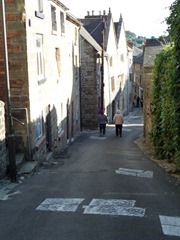 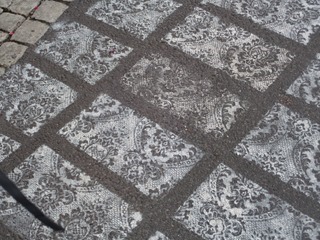
 Posted by: Lois Lindemann on: September 9th, 2013  Posted in: Everything Tags for this post: Wirksworth Festival 2013.  Comments are closed Comments are closedThe Art & Architecture Trail is easily the highlight of the Wirksworth Festival, with a wide variety of buildings becoming galleries for the day and playing host to an amazing number of artists. We spent most of Sunday visiting churches, gardens, the library, tiny cottages, large houses, schools, shops and even the railway station. The array of work on display was as large as ever, with paintings, photography, sculpture, baskets, pottery, jewellery, quilts and more.
We also spent quite a lot of time soaking up the atmosphere, whether it was enjoying a cup of coffee whilst listening to a busker in someone’s gorgeous courtyard garden, dancing to one of the bands that took the stage in the market place or sampling the beer at the local brewery. Definitely an eat, drink and be merry sort of day. With glorious sunshine. And art.
Not so many photos this year – I was still getting to grips with my new camera – but here’s a few highlights:
Some of Duncan Thurlby’s sculptures:
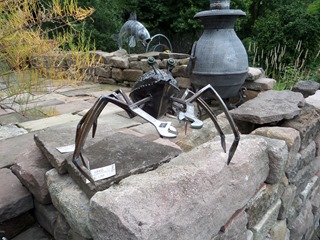 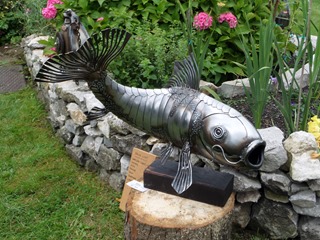 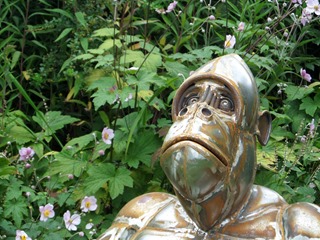 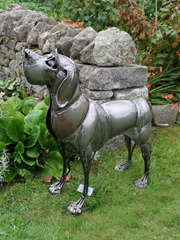 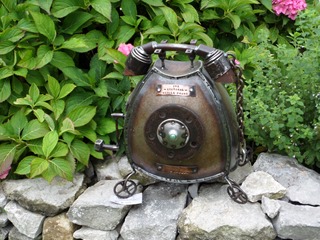 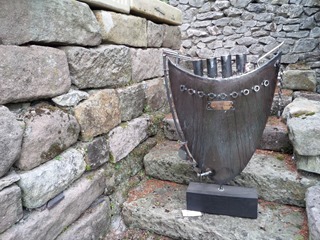 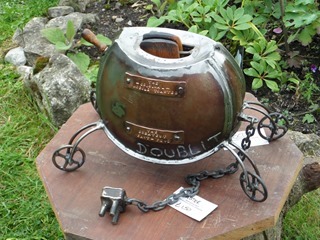
Paul Smith’s work always makes me smile:
 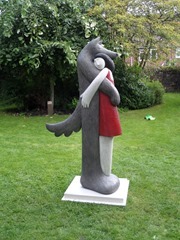
The local quilting group had a chapel full of beautiful quilts:
 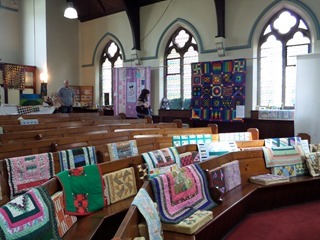 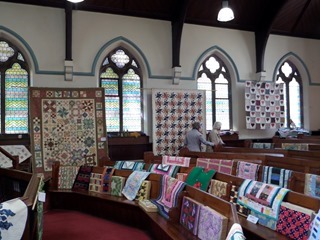
But was the window display at the vet’s surgery just a load of balls? ;P
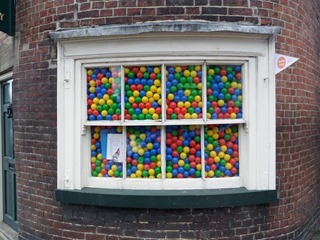
 Posted by: Lois Lindemann on: September 8th, 2013  Posted in: Life Tags for this post: Wirksworth Festival 2013.  Comments are closed Comments are closedSt Mary’s Church in Wirksworth held their annual clypping service today. The old Anglo-Saxon word clyppan, which means to embrace or clasp, is the etymological root of church clypping, but how and why this tradition started seems – like many such practices – to be rather unclear. At Wirksworth, the modern-day clypping is considered to show devotion and love for the church.
Clypping may be an ancient custom, but few churches continue it, so we thought we would take a look.
The clypping is a small part of a longer service. Part way through the service, the worshippers all go outside and form a circle around the building.
First the choir emerge from the church:
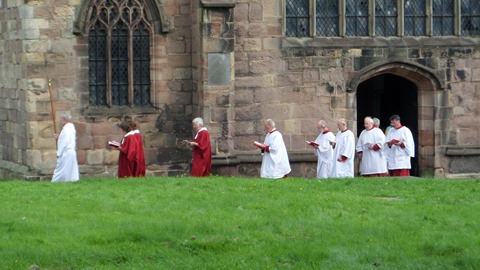
They are followed by the clergy and the rest of the congregation, who move around the church to form a circle. It’s a pretty sizeable church, but it’s also the weekend of the Wirksworth Festival, so David the vicar was able to persuade most of the not-inconsiderable crowd of onlookers to embrace this tradition and join the circle.
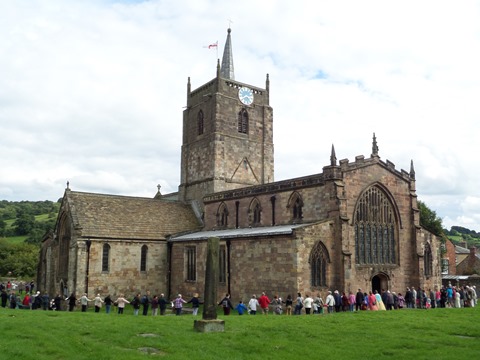
It’s an interesting but slightly peculiar thing to watch. Forming a circle is certainly symbolic, but it also looked rather like a giant version of a dance at a wedding reception. Apparently at some churches, dancing is part of the clypping, but not at St Mary’s, where everyone simply faces the church, holding hands whilst the choir processes around the church singing.
 Posted by: Lois Lindemann on: September 2nd, 2013  Posted in: Everything | Life Tags for this post: Quotes and Quips.  - (Comments are closed)Regret for wasted time is more wasted time.
Mason Cooley (via Lifehacker)
I’m very aware of just how fortunate I am to get such a long break over the summer. As usual, I started the holiday with a list of things to do that would take months to complete, so I set some priorities: I wanted to do interesting things, get fitter, complete the work for my TAM course, complete a few jobs around the house and garden and do some preparation for the new school year. Oh, and do some relaxing.
The holiday is almost over, but I think I’m pretty much on target. I’ve not done everything on my list, but I’m very happy about how I’ve spent my time – and I’m making the most of the last couple of days. No regrets for me.
 Posted by: Lois Lindemann on: August 31st, 2013  Posted in: The Universe Tags for this post: My Life | Photoblogging.  Comments are closed Comments are closedWe spent today in Maryport. The first time we visited here, we fell in love with the rugged beauty of this stretch of coastline. And, just like the people in films and holiday brochures, we had an entire beach to ourselves. Perfect.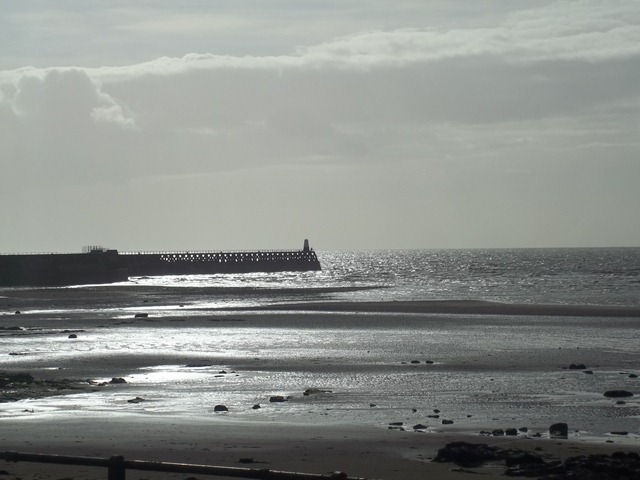 . .
 Posted by: Lois Lindemann on: August 30th, 2013  Posted in: The Universe Tags for this post: Photoblogging.  Comments are closed Comments are closed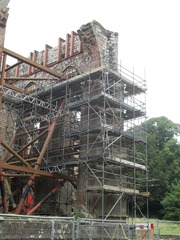
There is some extensive conservation work going on at Furness Abbey. Happily most of the abbey isn’t hiding behind scaffolding, so we were able to explore.
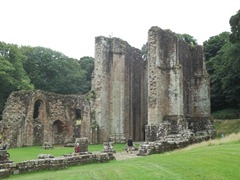 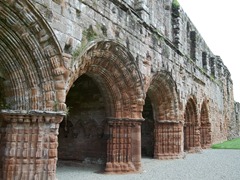 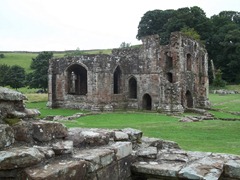
Looking at the remains of the nave, I found it difficult to imagine what it looked like when it was still a working abbey. Then I found myself wondering how long it will be before I can stand in the same place, wearing some hi-tech glasses, looking at the ruins, with computer generated images filling in the gaps.
Anyway, I’ve lots of other nice pictures to show you, but we’re currently in the Land of Limited Internet, so the rest will have to wait until I’ve managed to upload them.
 Posted by: Lois Lindemann on: August 28th, 2013  Posted in: The Universe Tags for this post: Derbyshire.  Comments are closed Comments are closed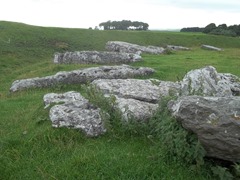 Tucked away in a quiet corner of Derbyshire is a rather magnificent ancient monument. Arbor Low is a Neolithic henge, consisting of a large earthwork, some 90 metres across, that encloses a circle of limestone blocks. It’s stunning to look at, so it’s no wonder it’s been referred to as ‘the Stonehenge of the North’. Tucked away in a quiet corner of Derbyshire is a rather magnificent ancient monument. Arbor Low is a Neolithic henge, consisting of a large earthwork, some 90 metres across, that encloses a circle of limestone blocks. It’s stunning to look at, so it’s no wonder it’s been referred to as ‘the Stonehenge of the North’.
Like all such sites, there seem to be more questions than answers. Is it a calendar, a religious site or something else? Were the stones always lying down, or did they once stand upright? Who lived here? Where did they live? Archaeologist Dr Ian Parker Heath was at the site when we visited. He is part of a team who are trying to investigate the area around Arbor Low, it will be interesting to see what they discover.
The site is well-signposted, but access is via privately owned land. The landowner requests that adults pay £1, which is left in an honesty box. This isn’t an unreasonable request in my opinion, given the number of people that were traipsing through the farm to get the site on the day that we visited.
Here’s a few pictures from our trip:
The earthen wall around the site looks quite impressive – just the sheer scale of it gives it a certain grandeur.
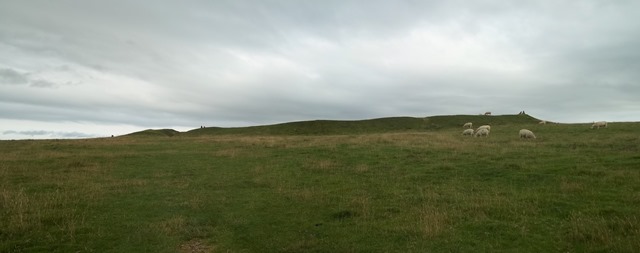
Once inside, the large stones look amazing. The two sheep grazing in the background should give you a sense of scale.

The site is used by a variety of people. Many, like us, are just visiting. The marks seen on the left of this photo were made by a pagan group. It looked like flour, so it should wash away in time:
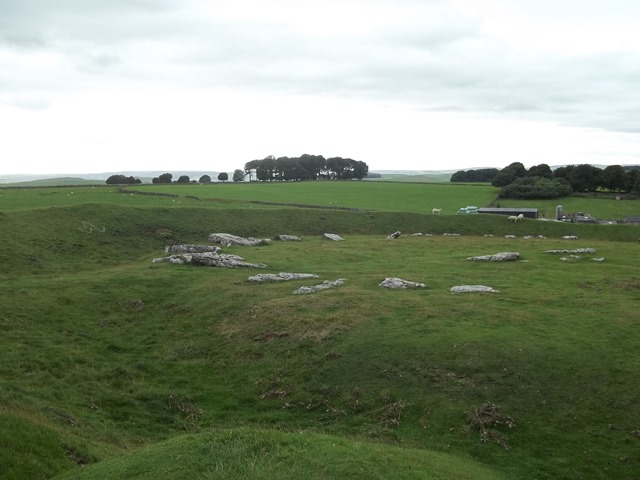
There is also a barrow nearby which can be seen from some way off. We set off across the fields to get a closer look. First we had to get past some sheep…
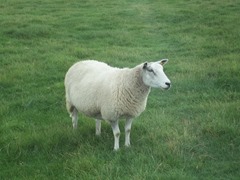
… but there were no convenient sheep providing a sense of scale for amateur photographers at Gibb Hill Barrow, so average-sized Mr TLC did that job:

Apparently this is actually two barrows, one built on top of the other – although I couldn’t see that from ground level.
If you are in the area, Arbor Low is well worth a visit. But I’d recommend wearing some sensible shoes!
All photos on this post are by Lois Lindemann and are licensed under a Creative Commons Attribution-Non-Commercial-Share Alike 2.0 UK: England & Wales License.
 Posted by: Lois Lindemann on: August 25th, 2013  Posted in: Life Tags for this post: My Life.  - (Comments are closed)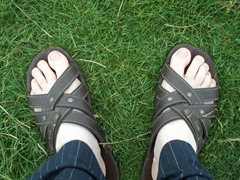 What’s that Billy Connolly quote? Something like “There’s no such thing as bad weather, just the wrong clothing.” What’s that Billy Connolly quote? Something like “There’s no such thing as bad weather, just the wrong clothing.”
However, different people clearly have different ideas about what the right clothing might be. There are always plenty of people out walking who are wearing clothing – especially footwear – that would be on my personal list of wrong. Most of these people seem quite happy though, so good luck to them.
I do remember one encounter with a group consisting of a man in his best shiny shoes, three women in unfeasibly high heels and two small children, one of whom was in a pushchair. They attempted to follow me & Mr TLC as we toiled up a very steep and extremely muddy bridle path. We were struggling in our sensibly stout and grippy boots, so it’s not surprising that our would-be followers didn’t get very far. Happily for them, there was an easier (if longer) alternative route along a nearby road.
So who was out in the wrong shoes today? Oh, that would be me. A spur of the moment decision to stop off and yomp over some fields left me climbing stiles, slithering along damp grassy banks and evading nettles (not entirely successfully) whilst wearing a pair of slippy sandals. In my defence, it was only a short walk – and the view was worth it. I’ll show you where we went once I’ve uploaded some photos. In the meantime, I think I’ll put my walking boots in the boot of the car before we go anywhere else.
 Posted by: Lois Lindemann on: August 24th, 2013  Posted in: The Universe Tags for this post:  Comments are closed Comments are closed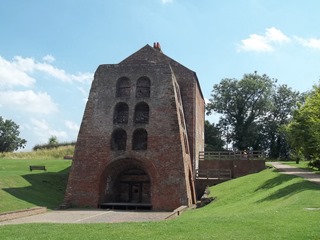 Tucked away in the village of Moira in Leicestershire is a surprisingly well-preserved relic of our industrial history. Tucked away in the village of Moira in Leicestershire is a surprisingly well-preserved relic of our industrial history.
Moira furnace is a nineteenth-century blast furnace. It was built in 1804, in what seemed to be the ideal location on the banks of the Ashby Canal, with plentiful coke and iron ore available locally. The Earl of Moira surely expected to see his furnace producing large quantities of iron and making a profit. Sadly for him, things did not work out. The furnace did produce saleable iron, but not for long. The information boards at the site describe how poor raw materials, bad management and issues with the design and construction of the furnace all contributed to commercial failure. Bad news for the Earl of Moira, but good news for us – the short working life of the furnace allowed a large part of it to survive intact.
Today the area around the former furnace is a country park, whilst the furnace itself houses a museum, but unfortunately we didn’t get to see that. Despite checking opening hours on the museum’s recently updated web page, we arrived to find the building bolted and barred and it remained closed all day. Even the shutters on the windows of the public toilets on the site remained locked shut – which was fine in the morning when the lights worked, but rather more challenging in the afternoon, when the power seemed to be off!
The outside of the furnace was still visible, so we admired it whilst we ate our picnic and I attempted to impress Mr TLC with my metallurgical knowledge by explaining how the magic of iron ore + coke + heat results in iron (and a lot of impurities). The outside of the building did look impressive – I liked the way that brick paving had been used to show where the molten iron was tapped from the hearth into “pigs”.
Having got as much as we could from the furnace itself, we whiled away the rest of the afternoon by strolling along the short, but rather pretty, section of the Ashby Canal and admiring the Moira Furnace barge before setting off to explore some local footpaths. We almost missed the nearby lime kilns, but they were definitely worth a look. There are also a few interesting bits of artwork dotted around the site, so there’s plenty to see.
We didn’t exactly have a blast at Moira furnace, but we had a nice walk with some interesting things to look at, so that’s not bad.
Moira Furnace and Ashby Canal:
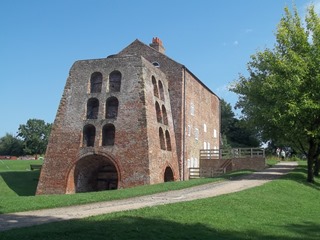 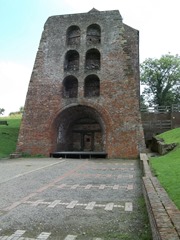 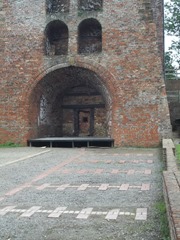 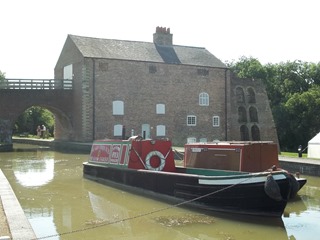 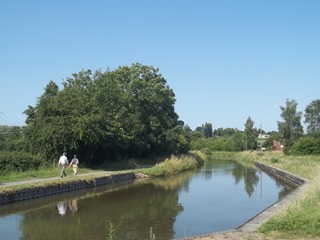
The Lime Kilns:
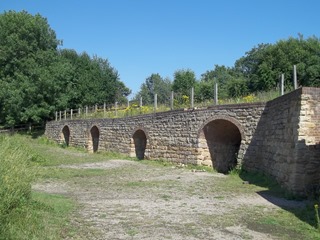 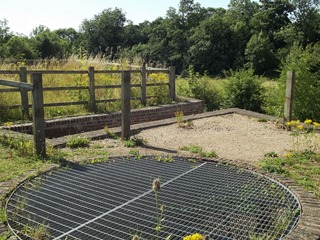 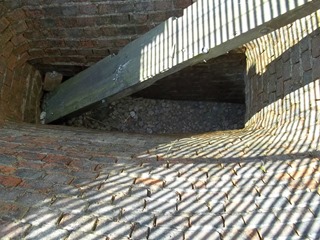 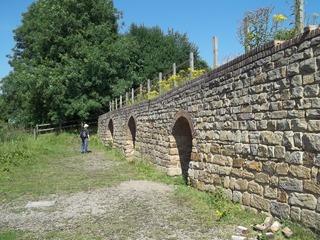 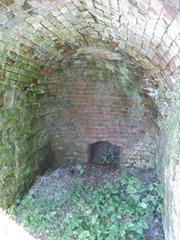
Artwork at the site:
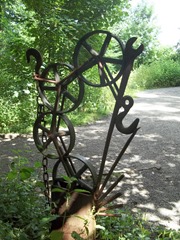 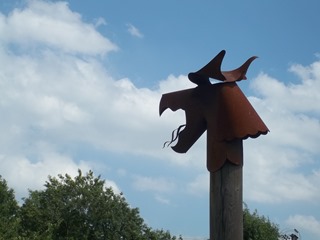
Useful links:
Visitor information (although our experience suggests that this may not be entirely accurate!)
There is lots of information about the history of Moira Furnace in their education pack, which is aimed at teachers, but has useful information for anyone who is interested in the history of the site.
All photos: by Lois Lindemann, licensed under a Creative Commons Attribution-Non-Commercial-Share Alike 2.0 UK: England & Wales License.
 Posted by: Lois Lindemann on: August 23rd, 2013  Posted in: The Universe Tags for this post: Sheffield.  - (Comments are closed)How do I know that Mr TLC and I are geeks? Because when we first saw this building being constructed we said “Ooh look, it’s a Borg Cube!” Obviously we followed that up with “ We are the Borg. Resistance is futile. You will be assimilated. Your technological and biological distinctiveness will be added to our own,“ because this is the kind of daft stuff we like to say when we see a giant cube in the centre of Sheffield. The Borg are the most splendidly scary Star Trek villains ever.
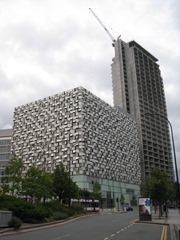 
The good folk of Sheffield are renowned for being down to earth, so most of them saw this building in a rather different light. It’s known locally as the Cheese Grater. No Borg cubes for us. Oh well, I expect any visiting Borg will still feel at home when they see it.
Surprisingly, this landmark building turned out to be a multi-story car park, not something that is normally associated with architectural innovation. (Bravo Allies and Morrison!)
The Cheese Grater has been part of our skyline for a few years now, but it made the news this week after being awarded the distinctly unimpressive title “third coolest car park in the world” in the even less impressive “cool car park awards made up by the marketing departments of a car parking company and a magazine”. Faint praise indeed.
The title may be utterly unimpressive, but I think the building is fantastic. It’s certainly the coolest car park that I’ve ever seen.
 
It looks great at night too:

The photo the cheese grater @ night by Mike Smith on Flickr is used under Creative Commons Licence. Other photos by Lois Lindemann.
|
|


















































